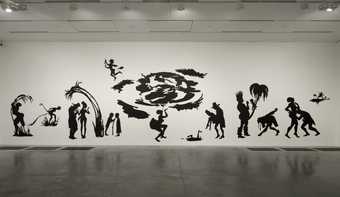
Kara Walker
Grub for Sharks: A Concession to the Negro Populace (2004)
Tate
Project Space presents the work of artists who have been specially commissioned by Tate Liverpool to make work for the ground floor gallery. This is the sixth Project Space and presents new work by one of the most successful African-American artists, Kara Walker.
Walker came to international attention in 1994 with an exhibition at the Drawing Center in New York, which featured room-sized installations of silhouette cut-outs, depicting controversial and provocative themes. Central to her work is Black history, its telling and re-telling, and the effect this has on African-Americans today. She attacks racial myth and stereotypes, exploring issues such as slavery, sexuality, oppression and domination.
For Walker, her use of the silhouette – once used for portraits and caricatures, and primarily a decorative craft – is an effective way of simplifying complex ideas. She likens it to stereotyping, in which individual identities, situations and personalities are reduced and distorted into easily-caricatured forms.
The project was inspired by a work by JMW Turner, Slavers Throwing overboard the Dead and the Dying – Typhon* Coming On, and the book Liverpool & Slavery: An Historical Account of the Liverpool-African Slave Trade, acquired by the artist during a research visit to the Merseyside Maritime Museum. Grub for Sharks is a reference to the practice of throwing slaves to their death in the sea, in an attempt to lighten ships before a storm – schools of sharks were known to trail ships for this reason.
Kara Walker was born in Stockton, California in 1969. Her work has been exhibited at the Museum of Modern Art, New York, the San Francisco Museum of Modern Art, the Solomon R Guggenheim Museum, and the Whitney Museum of American Art. In 1997, she received a MacArthur Foundation Award, and in 2002 she represented the US at the São Paulo Biennale in Brazil. She lives in New York City and teaches at Columbia University. This is her first solo exhibition in the UK.
* spelling of typhoon at the time the work was painted.
I am in love with the conceits of 'being an artist', of being 'free' and 'black', of being an entrepreneur the murky historical ambiguities that lead to such concepts (What does art mean? What does Black mean? What are the limits of commerce?). For the Liverpool exhibition I am interested in drawing out ambiguities relating to the Institution (The Tate) and its relationship to the Dock and resultant trepidation regarding pleasing the surrounding Black populace, descendants of the colonialism, slavery, inheritors of big chips on large shoulders.
But it doesn't end there. Certainly, as an artist, one of my 'strengths' might be my ability to magically bridge long standing inequities by virtue of my being Black, my (somewhat) high profile, with work that is, say, tough on the issues relevant to the Institution. However, there is a suspicion (my own, perhaps) that the trouble with Historical Slavery, Race and social inequity is that it is so irresolute, and so mind-bogglingly personal that just broaching the subject leads to the reiteration of its terms. Therefore (in this paranoid vision) I become the House Servant to the Institution, throwing the 'Negro Populace' a bone. 'Grub for Sharks' is intentionally ambiguous – an earlier reference to the act of throwing sick or dying slaves overboard – perhaps my offering to the Institution, perhaps the Institution's offering to a hungry, underrepresented audience. 'A concession' – I hunker down and do as I am instructed – do so dutifully, even, and give you a coupon, a free pass. Enter at your own risk.
Of course, the landscape I immediately referred to, when offered this show, was Turner's Slave Ship, always a gruesome favourite. A full-on Romantic seascape with the manacled brown hands and feet of slaves as they meet 'a watery death' (the quotes are my own, but the painting nearly screams the sentiment).
I am working in two diverging directions. The first involves what I call the 'Negro in the Landscape' – as in the posture of blacks as they have been represented in fine art, commercial art and historical engravings with reference to location – in the Sea, on the Land, and what effect their (our) iconic presence might have on the space.
The other direction is the Travelogue, specifically as in the late nineteenth-century book Liverpool and Slavery: An Historical Account of the Liverpool-African Slave Trade but also Swift's Gulliver's Travels. I think of the images in the show as a series of vignettes rather than a linear sequence, as with much of the rest of my work. In effect I have been fabricating a very brief pictorial narrative around the idea of a revolution among Black Women, the reinstitution of slavery and the abandonment of reason. Naturally it is drawn from life.
Kara Walker, 2004
During Black History Month, Tate Liverpool is running free introductory workshops to the Kara Walker exhibition. Focusing on issues such as race, power, oppresion and identity, the workshops are aimed at community and youth groups. There will be a staff training session on using the exhibition for staff in the social services and caring sector. This session is led by Southern Voices, an educational organisation concerned with raising awareness on development issues for people in the Southern hemisphere.
